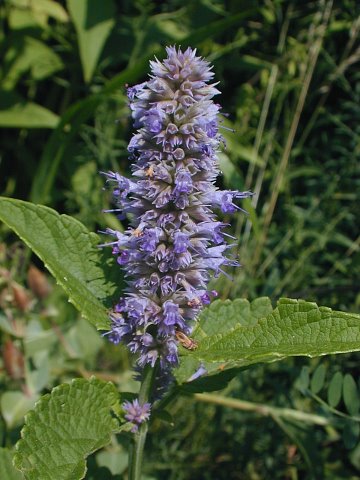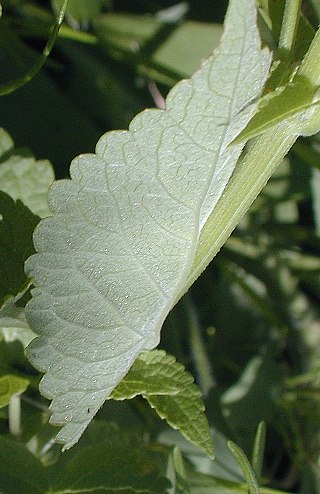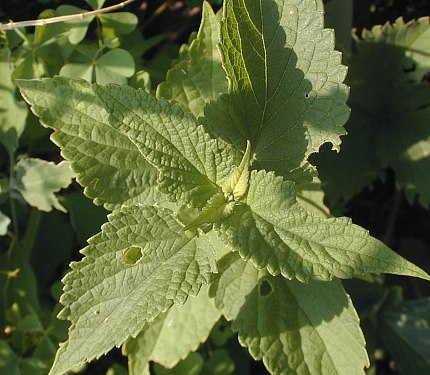Description: This perennial plant is 2-3½' tall, branching occasionally near the apex. The four-angled stems are light green and glabrous to finely pubescent. The opposite leaves are up to 4" long and 2" across, and they have short petioles. The leaves are cordate to broadly lanceolate in shape and their margins are crenate to crenate-serrate. The upper surface of the leaves is conspicuously veined and dull green, while the lower surface is white and finely canescent. The foliage has an anise scent.

The
upper stems
terminate in spikes of flowers about 3-6" long. The small flowers are
arranged in dense whorls that are crowded along the spike, although
sometimes the whorls are less crowded and more interrupted. The calyx
of a flower is tubular and has five teeth; it is usually dull
blue-violet or a similar color, becoming more colorful toward its tips.
The tubular flowers are about 1/3" (8 mm.) long, extending beyond the
calyx.
They are blue-violet. The corolla of a flower is divided into a short
upper lip and a longer lower lip. The lower lip has 2 small lateral
lobes and a larger central lobe. Exerted from the throat of the flower
are 4 stamens with blue-violet anthers, and a style that is cleft
toward its tip. The flowers bloom in scattered locations
along the
spikes for about 1-2 months from mid- to late summer. During this time,
calyx of each flower remains somewhat colorful. There is no floral
scent. The flowers are replaced by nutlets that are oval-shaped and
smooth. The
root system produces a taproot.
Cultivation:
The preference is full or partial sun, and mesic to dry conditions. The
soil can consist of loam, clay-loam, or contain some rocky material.
Foliar disease isn't a significant problem, although some of the lower
leaves may drop from the central stem in response to a drought.
Occasionally, slugs and insects will feed on the leaves, creating
holes. This member of the Mint family is more resistant to drought than
many others.

Range & Habitat:
In the wild, Anise Hyssop is rare in Illinois; it is known to occur in
only Menard county in central Illinois (see Distribution
Map).
This species is more common in areas that lie northwest
of Illinois. Typical habitats include openings in dry upland forests,
upland areas of prairies, scrubby barrens, and thickets. Cultivated
forms of Anise Hyssop are often grown in flower gardens; these
cultivars are often hybrids and vary in their fidelity to the wild
forms of this plant. In Menard county, the population of plants was
likely introduced. Other populations in the wild, if they exist,
are likely to be plants that have escaped cultivation.
Faunal Associations:
The flowers are cross-pollinated primarily by honeybees, bumblebees,
digger bees (Melissodes
spp.), leaf-cutting bees (Megachile spp.),
Halictid bees (Lasioglossum
spp., etc.), and Masked bees (Hylaeus spp.),
which seek nectar or pollen. The flowers are also visited by an
oligolectic bee, Dufourea monardae, which has
extended its range into Illinois. Other occasional floral visitors are
Syrphid flies, bee flies, and various butterflies, skippers, and moths.
Mammalian herbivores normally avoid consumption of this plant as the
anise scent of the foliage is repugnant to them. The anise scent may
also deter some leaf-chewing insect species.
Photographic Location:
The photographs were taken of plants growing in the wildflower garden
of the webmaster in Urbana, Illinois.

Comments: Because of its rarity, Anise Hyssop is not normally thought of as a prairie species in Illinois, nor does it appear in many field guides of prairie plants for the tallgrass prairie. This plant does occur in the northwestern area of the tallgrass prairie, however, with a few scattered remnant populations elsewhere. Other members of this genus are woodland species. One of them, Agastache scrophulariaefolia (Purple Giant Hyssop), has flowers with similar coloration to Anise Hyssop. However, the foliage of Purple Giant Hyssop doesn't have an anise scent and the the undersides of its leaves are green, rather than white. Purple Giant Hyssop is more pubescent or hairier than Anise Hyssop, and it tends to be a taller plant. The calyx of each flower remains green for this species, unlike Anise Hyssop, where each calyx assumes a coloration that is more similar to the flowers. This latter characteristic can cause Anise Hyssop to look like it is in flower, even when it is not.